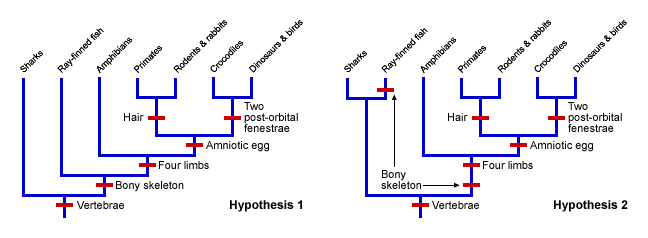Research indicates that students learn better if they are actively engaged, as opposed to passively receiving information. Incorporating more active learning about evolution into a lecture-based course, doesn’t have to be time consuming or difficult. Below, we provide three types of PowerPoint slides that can be used to engage students more actively in your lectures on evolution. Incorporate any of these slides into your lecture as is topically appropriate.
Sample minute paper slides
Minute papers are brief, in-class writing exercises, typically carried out at the end of a class session. Instructors ask students to write a few sentences (or more) about a topic in order to encourage students to process information. Click the questions below in order to download individual slides, or click here to download the whole slide set. For more details about how to use these slides in lecture, visit Using active-learning slides with students.
- What is evolution?
- Is evolution a theory, a fact, or something else entirely? Why?
- What evidence supports the theory of evolution?
- What is the fossil record’s unique contribution to our understanding of evolution?
- What do you think it means when a species is called a “living fossil?”
- What are transitional features?
- Is it correct to say that humans evolved from chimpanzees? Why or why not?
- Describe the mechanisms of evolution.
- In order for natural selection to occur in a system, what characteristics must the system have?
- Do vestigial structures necessarily disappear through evolution?
- Is antibiotic resistance an example of evolution?
- What does it mean to be fit in an evolutionary sense?
- Why are small populations more strongly affected by genetic drift than large ones?
- What is coevolution?
- Compare and contrast the biological species concept and the phylogenetic species concept.
- Describe a situation in which it would be difficult to apply the biological species concept and explain why it would be difficult.
- How is allopatric speciation similar to and different from sympatric speciation?
- Select the more parsimonious phylogeny.

Sample personal response question slides
These multiple choice questions check the current state of student understanding and/or advance understanding in some way. The class can use response technology (like “clickers”) to record their answers, or may hold up colored pieces of paper or their hands. Used at the beginning of class, this type of question can assess how well students have understood assigned reading or material presented in the previous lecture. During the lecture, the instructor can use these questions to assess current understanding of the lecture material, and based on the result, can further elucidate the concept. Click the topics below in order to download the slide, or click here to download the whole slide set. For more details about how to use these slides in lecture, visit Using active-learning slides with students.
- Randomness of mutation
- How natural selection works
- Natural selection misconception in the context of head lice
- Natural selection misconception in the context of bacteria
- Fitness definition
- Survival of the fit enough
- Genetic drift misconception
- Genetic drift and fixation
- Population genetics calculation
- Topology of equivalent phylogenies
- Phylogenetic misconception
- Reading a phylogeny 1
- Reading a phylogeny 2
- Reading a phylogeny 3
Sample problem-based discussion slides
In this technique, the instructor posts a written description of a scientific problem or a diagram, table, or graph, along with a list of questions. Students first think individually about the questions and then pair up and take turns explaining their answers to each other and filling gaps in each other’s knowledge. The instructor may wish to call on students to answer individual questions, or may ask if the discussion raised any questions they would like to ask in class. Click the topics below in order to download the slide sets. For more details about how to use these slides in lecture, visit Using active-learning slides with students.
- Population genetics simulation of drift
- Population genetics calculations and Hardy-Weinberg
- Natural selection in Darwin’s finches
Authors:
Lisa A. Urry, Jean DeSaix, Kirsten Swinstrom, Nan Ho, Jim Smith, and Anna Thanukos
